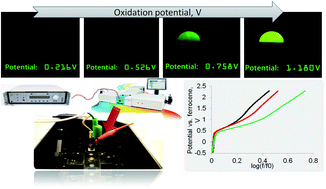Sensitivity of activatable reactive oxygen species probes by fluorescence spectroelectrochemistry†
Abstract
We have developed a new analytical method of evaluating activatable

* Corresponding authors
a
Washington University School of Medicine, Department of Radiology, 510 S. Kingshighway, St. Louis, MO 63110, USA
E-mail:
berezinm@mir.wustl.edu
Tel: +1 314 747 0701
We have developed a new analytical method of evaluating activatable

 Please wait while we load your content...
Something went wrong. Try again?
Please wait while we load your content...
Something went wrong. Try again?
S. T. Wang, N. G. Zhegalova, T. P. Gustafson, A. Zhou, J. Sher, S. Achilefu, O. Y. Berezin and M. Y. Berezin, Analyst, 2013, 138, 4363 DOI: 10.1039/C3AN00459G
To request permission to reproduce material from this article, please go to the Copyright Clearance Center request page.
If you are an author contributing to an RSC publication, you do not need to request permission provided correct acknowledgement is given.
If you are the author of this article, you do not need to request permission to reproduce figures and diagrams provided correct acknowledgement is given. If you want to reproduce the whole article in a third-party publication (excluding your thesis/dissertation for which permission is not required) please go to the Copyright Clearance Center request page.
Read more about how to correctly acknowledge RSC content.
 Fetching data from CrossRef.
Fetching data from CrossRef.
This may take some time to load.
Loading related content
